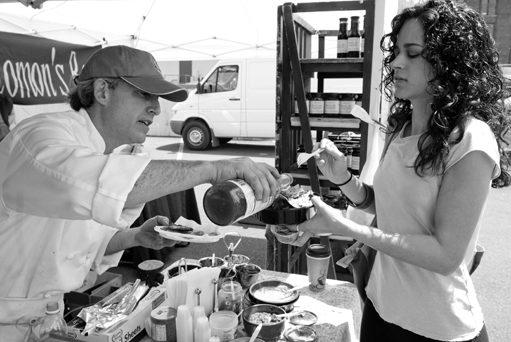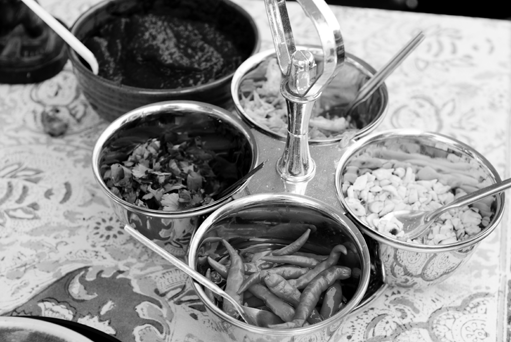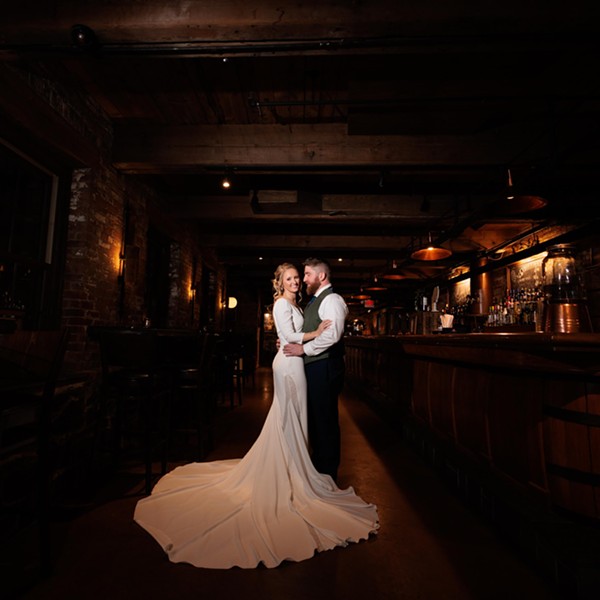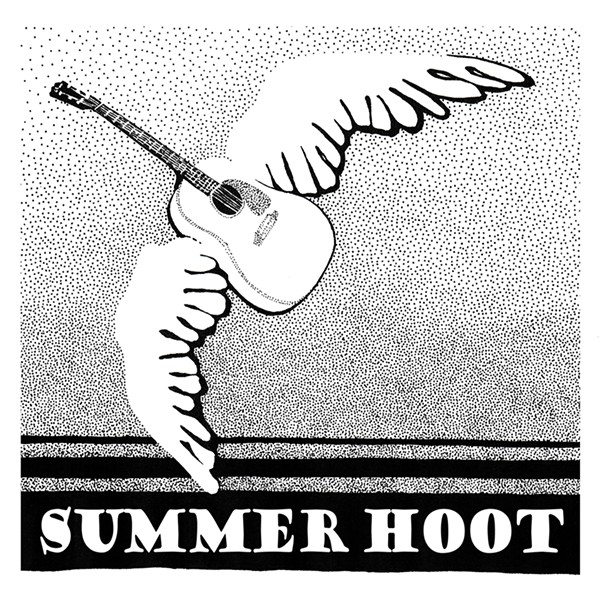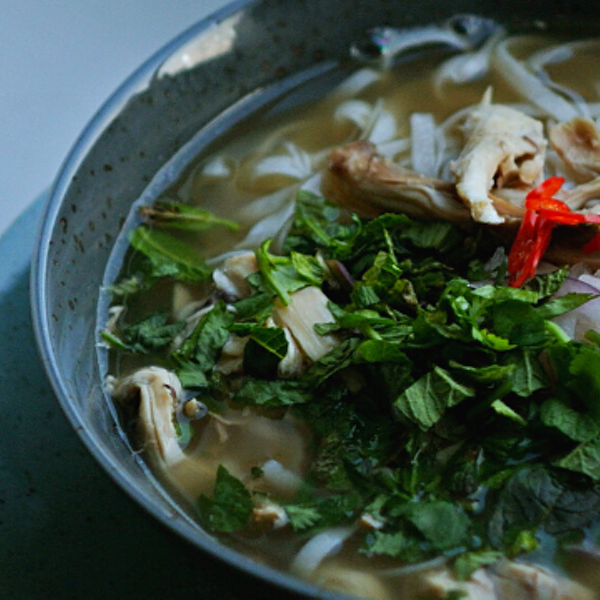As much as anything, it was the “30-30-30-10” rule that sent Mike Gordon on a food pilgrimage to Thailand. That’s the axiom of restaurant economics Gordon learned as a student at the Culinary Institute of America more than 15 years ago. Roughly 30 percent of your income goes into food costs, 30 percent into labor and 30 percent into overhead. What’s left, that’s yours. Maybe.
“Do everything by the book, and you make 10-percent profit,” Gordon explains. “You’re investing 200 grand in a business. If you’re lucky, and no one’s stealing from you or throwing meat in his car or robbing the register, you might make 10 cents on the dollar. That’s pretty tight.”
So as Gordon rose from dishwasher to chef through a succession of Albany, New York, restaurants, he took careful notes and gathered one essential fact. Most of the restaurants that succeed are either really big or really small. In a very competitive world, independents—who can’t advertise as much as the chains and can’t bargain with mammoth food distributors like SYSCO—have a tougher row to hoe. This is not a problem if you haven’t known since you were eight years old that you wanted to be a chef, and if the need to create and serve innovative food isn’t in your blood. But for Mike Gordon, who fantasized about owning his own place, it was a definite problem.
A problem he solved, inadvertently, by going broke and getting mobile. In 1999, Gordon’s marriage fell apart, he lost custody of his kids and, struggling with a drinking problem, he got fired, all within a few months. Just as he hit bottom, he found himself in love with a woman named Susan. The day he was driving north to Keene Valley, New York, to move in with her, Gordon passed a hot dog stand on the highway that cuts through the Adirondacks. “You know, I could do that,” he told himself. “But I would do it with a fish fry.”
This would normally be an incongruous thought for a CIA-trained chef, but Gordon was on the rebound. As it turned out, Susan knew the hot-dog guy, and he in turn knew someone with a fully-equipped Airstream restaurant trailer and an old Ryder van to pull it and carry supplies, all for sale at $16,000. Of course, that was money Mike didn’t have. But Susan did. Well, she had a credit card at least, and volunteered to charge the whole shot for him—cash advance.
There’s a big truck turnaround at the intersection of routes 9N and 72, not far from Lake Placid, and that’s where Gordon set up: “I bought a big generator. I hung up Christmas lights, and had a 500-watt halogen light bulb shining on the side of the Ryder truck: Mike’s Fish Fry—One Bite and You’re Hooked. You could see it from a mile away.” And with the location came a built-in clientele. “All the skiers would come off Whiteface Mountain at four o’clock, starving, and the word got out I had home-cooked food that was cheaper and better than the food at Whiteface.”
In no time at all, Gordon’s fish fry took off. Maybe it was the Icelandic haddock he used, or his secret breading, or his crab cake specials. Whatever it was, it worked. By the end of his first year, he had paid Susan back. He bought some ‘70s-era vinyl bar stools and set them at the drop-down metal shelf so he could interact with the passing parade. “The different people who showed up were amazing,” he recalls. “Skiers, ice climbers, visitors to Ray Brook federal prison, city people perched next to elite, old-money types alongside truck drivers next to whacked-out backwoods folks—all of humanity, sitting there together, eating my fish fries.”
After his first season, Gordon had an epiphany. Susan had returned from teaching in Pakistan and one night she cooked a venison curry for him. “It was a revelation,” he says. “After years of eating Western food, I found a cuisine that I really liked.”
So Gordon quickly added Indian food to his menu. He made a tasty dal, spread it over chicken curry, and rolled it in a foil-wrapped tortilla that people could eat while they drove. Soon the Indian wraps were selling as well as the fish, and ingredients like lentils and the vegetables that form the basis of Indian food were a lot cheaper than haddock.
For two years Gordon sold both, testing Indian recipes and adding new dishes as he developed them. In 2002, the couple moved to Greenwich, New York, in Washington County. He couldn’t find a location for Mike’s Fish Fry that clicked, so Gordon sold the Airstream and bought a portable cart. Thunder Mountain Curry was born.
The chef decided to sell his Indian meals at the weekly Farmer’s Market in Troy, New York. His first week there, a professor from Rensselaer Polytechnic Institute suggested he set up in front of RPI, which has a lot of Indian students and where business should be good.
The location wasn’t just good for sales. At RPI, Gordon’s Indian customers began to give him favorite recipes for special meals their families used to make. He learned as well of the finger food (chaat) that the street vendors (wallahs) sold in their stands (dhabas). “Welcome to my dhaba,” Gordon would say to his customers, “I’m Mike, your friendly chaat wallah.” People loved it.
After two years of Thunder Mountain, Gordon had his second food epiphany. Why cook just Indian, he asked himself, when there’s a whole pan-Asian cuisine out there? He had cooked Indonesian, and knew other Southeast Asian dishes, but his favorite cuisine was from Thailand. He taught himself to cook Thai from cookbooks, and soon spring rolls and corn fritters and Thai curries were added to the dhaba, and people couldn’t get enough of them either.
But for Gordon, something was missing. He wanted to truly understand the art of Thai food, its “nuances,” as he puts it, and he wanted to see Thailand’s fabled street merchants in action. So in January of this year, off he went to immerse himself for three weeks in the country’s culture and cuisines. In Chiang Mai, in northwestern Thailand, he studied that province’s Chinese-influenced dishes. In Bangkok, his eyes stinging from the pollution, he bought beers and observed the street vendors. They were mostly women, and Gordon became fascinated with their fluid movements. He couldn’t talk to them—none of them spoke English—but he noted the dishes, watched them prepare the ingredients, and admired their agility.
A tip from an expatriate sent Gordon south, to Khojum, an island you won’t find in the guidebooks. There, he did an eight-day apprenticeship with “Mama,” a rotund Thai woman in her 60s who cooked like an angel. In Mama’s kitchen, Gordon found the same seasonings he buys in the Asian market in Albany—squid fish sauce, sriracha chili sauce, soybean paste—but discovered something you can’t get from ingredients and cookbooks: nuance. As much as anything, that’s what he brought back with him.
As Gordon moves around the kitchen he leases in Troy’s Arts Center of the Capital Region—chopping, stirring, pivoting, showing the way Mama moved when she cooked, describing how she added tomatoes to her curry just before serving it—he acknowledges the difficulty of capturing the “Zen” of her preparation techniques and the ethereal taste of her cooking.
"With Asian cuisine, it’s complex and simple at the same time. It’s multi-dimensional,” he observes. “European cuisine is two-dimensional—you can have a dish that’s either sweet or hot. Asian cuisine is different. It’s sweet, hot, salty, sour, and bitter all at the same time, though maybe not in a single bite. With an Asian meal, you should have all those flavors. If you do it right and eat in balance, then you feel contentment and satisfaction afterwards.”
Gordon savors the Thai habit of sharing, and he tries to embody it at his stand. Thunder Mountain Curry offers not just Indian and Thai food, but dishes from Sri Lanka, Indonesia, China and the whole of Southeast Asia. He’s at the farmers’ market every Saturday, and near the RPI Student Union during the week. And he has expanded into catering.
For now, he’s beaten the “30-30-30-10” rule. “I do most of the work myself, so the labor is lower, and my fixed costs are lower,” he says. “The food is higher than 30 percent, because the quality is high. But I’m doing all right.” Better than a dime on the dollar, he allowed. The idea of expanding the business and hiring help still makes him nervous, though. Thunder Mountain Curry is small enough to retain its elusive culinary nuance, and good enough to survive on the streets of Troy.
“For the last few years, I’ve told customers I’d never own a restaurant,” Gordon says, “but I don’t say that anymore. Whenever you say you’ll never do something, you end up doing it. I don’t want to jinx myself.”








